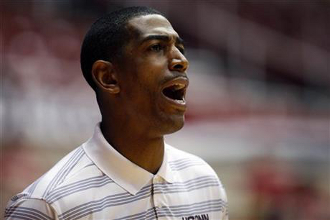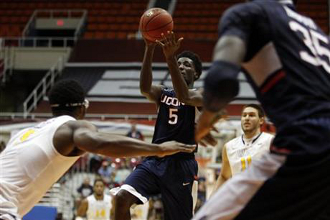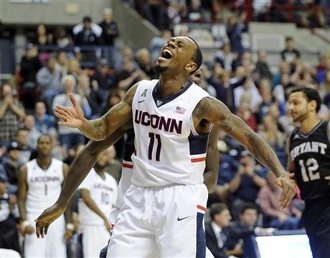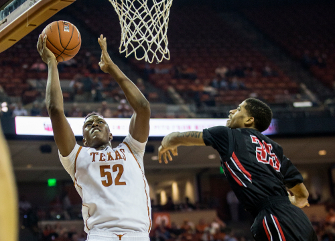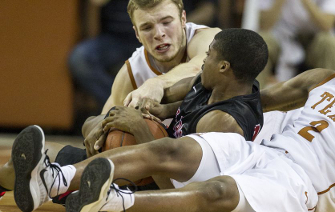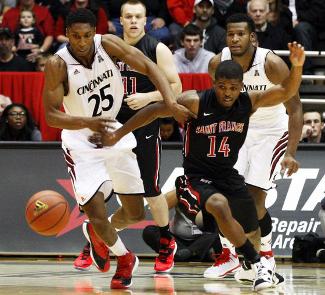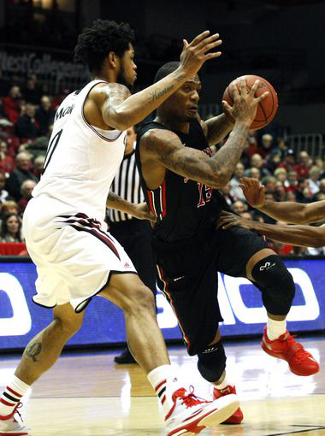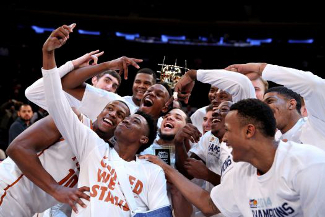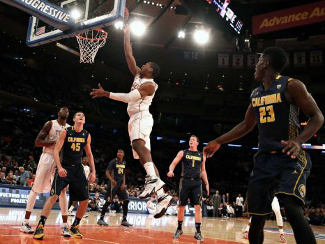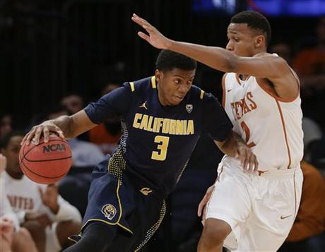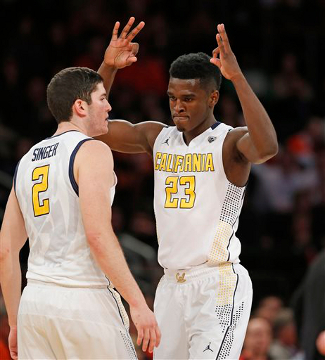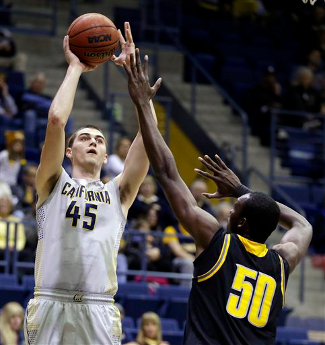Gampel Pavilion | Storrs, CT | Tip: 11 A.M. CT | TV: ESPN2 Vegas: UConn -1 | KenPom: UConn, 64-63 (51%) The Texas Longhorns are off to a 5-0 start for the first time since the 2009-10 season, when the team reeled off 17 straight wins to start the year and ascended to the nation’s No. 1 ranking. To match that feat, this year’s squad would have to navigate a non-conference minefield, beginning with this morning’s game at the defending national champions, and also including next weekend’s road trip to last year’s national runner-up. Oh, and did I mention that they’ll have to do that without their starting point guard, and with his backup nursing a sore foot?
Kevin Ollie won an NCAA title in just his second year While the odds of another 17-0 start are slim, the Longhorns still have a good chance to leave Storrs with a win today. Texas is a slight underdog according to Vegas, but their size and experience match up well against a UConn team that is thin in the frontcourt and lost quite a bit from last year’s title team. If the Longhorns can emerge victorious on the road, they will also end an impressive streak of 44 consecutive non-conference wins for UConn at Gampel, dating back to 2001. By the numbers The Huskies are ranked in the top 40 in both adjusted offensive and defensive efficiency, according to Ken Pomeroy, although they’ve achieved those marks without any dominant numbers in specific categories. Their tempo trends towards the slower half of Division I, with the team playing an adjusted 66.4 possessions per game. Mix all of those numbers together, and you can see why UConn’s three wins have come by an average of ten points, even though all three were still battles into the second half. The Huskies don’t wow you with any particular aspect of their game, but they are good enough to grind out a win in crunch time. Where UConn does stand out somewhat in statistical categories is on the interior of the defensive end. Thanks to a stout rim protector — we’ll have more on him later — UConn has the nation’s 56th-best block rate at 13.3%, and they boast the nation’s 45th-best defensive rebounding mark, as they limit opponents to winning back just 26.2% of their misses. On offense, two numbers tell the statistical tale. UConn’s best ranking is their two-point field-goal percentage of 51.7%, which is 78th out of 351 Division I teams. The other half of the story is told by their 42.4% team assist rate, which is ranked 317th out of the 351 teams. UConn has an incredible playmaker in the backcourt — another guy we’ll cover in just a moment — but no one else that can consistently beat the defense and set up teammates. Meet the Huskies That playmaker for the Huskies is Ryan Boatright (No. 11), a senior guard who is the unquestioned team leader, and the best returning piece from last year’s national championship team. Boatright is the one player who can consistently create his own shot with the bounce, and also the only one who can use the dribble to create looks for his teammates. Boatright’s personal assist ratio of 27.8% is more than double that of the second-best UConn assist rate. Boatright has a bit of playground flair to his game, which you can see when he gets locked in on a defender and decides to beat him one-on-one. With a mix of crossovers, spin moves, behind-the-back and between-the-leg dribbles, Boatright can quickly break down a defender and bring the crowd to life in the blink of an eye. On the other end, Boatright is a fantastic on-ball defender, and his quick hands often lead to steals and fast break buckets on the other end. With Isaiah Taylor out of action today, Javan Felix and the other Texas guards will have to be very careful against Boatright in the half-court sets. Joining Boatright in the backcourt is N.C. State transfer Rodney Purvis (No. 44). The sophomore is a stout 6’4″ guard who can get to the rim, but has yet to make a major impact at UConn. After missing the first game of the season due to a minor NCAA infraction, Purvis has made just 37% of his shots, and connected on only 30.8% of his attempts from long range.
Daniel Hamilton has impressed as a freshman The team’s most exciting new addition comes in the form of lanky wingman Daniel Hamilton (No. 5). The younger brother of former Longhorn Jordan Hamilton, Daniel has turned out to be the team’s best three-point shooter, and has also frequently used that long-range threat to beat defenders with strong head fakes behind the arc. While Hamilton has proven to be an explosive scorer that can heat up in a hurry, his decision-making has been questionable through his first four collegiate games. He often jumps before passing the ball, even though he’s a very long 6’7″, which leads to unnecessary turnovers. On the year, Hamilton has the team’s highest turnover rate, with a 31.2% mark. Down low, the Huskies have a formidable big man in Amida Brimah (No. 35), the rim protector we mentioned earlier. Brimah’s block percentage of 13.3% is the 17th-highest in Division I, and it allows Boatright and the Huskies to extend their pressure beyond the perimeter, since he’s always lurking in the middle to clean up any penetration. On the other end, Brimah has improved his game and worked on the short jumpers and a back-to-the-basket game. Although those skills are still works in progress, the big man still consistently scores in the pick-and-roll, with Boatright and Hamilton often the trigger men. Joining Brimah in the frontcourt is sophomore Kentan Facey (No. 12), a Jamaican kid who didn’t really start playing basketball until he was 15, instead focusing on soccer and cricket. Even with the late start, Facey has developed excellent rebounding skills and makes good cuts without the ball. The big man can track down boards that are not in his area, and he leads the team in rebounding percentage as a result. The Huskies are rather thin in the frontcourt, with Phillip Nolan (No. 1) the only real option behind Brimah and Facey. He actually has some nice post moves, but has struggled with foul trouble that limits his effectiveness. The 6’10” junior is playing less than nine minutes a game, while getting called for fouls at a rate of nearly 13 per 40 minutes. In addition to Nolan, the Huskies also have a stout 6’8″ freshman named Rakim “Rock” Lubin (No. 14). Lubin was suspended while the team was in Puerto Rico and was reinstated late this week, so his minutes may be limited today. In the backcourt, both Terrence Samuel (No. 3) and Sam Cassell, Jr. (No. 10) provide some depth. Both can create their own shot, although Samuel has struggled at times this year to finish at the rim. While Cassell was looked to as a potential three-point threat at the beginning of the year, he’s yet to deliver, making just 22% of his 18 attempts this season. Keys to the Game
Ryan Boatright is an explosive scoring threat 1. Don’t give Boatright easy buckets – Boatright can get his own looks off the bounce, and will drill a pull-up jumper right in a defender’s eye. With his ability to score in an instant and take over a basketball game, the Longhorns cannot afford to give him any easy buckets. The Texas guards must take care of the ball at the top of the key to limit turnovers and fast break buckets, and the Longhorns must stop Boatright and the ball in transition. 2. Attack Brimah early and often – Without much behind Brimah on the depth chart, the Longhorns need to focus on putting the big man in foul trouble early. If Texas can put him on the bench, it completely changes the UConn defensive scheme, as their pressure defense would be more susceptible to finishes at the rim, and it would take away one of their big offensive weapons on the pick and roll. 3. Look for transition opportunities – When the UConn defense gets set, their pressure can be hard to handle. But, as opponents have proven this year, the Huskies can be beaten in the transition game, as they often fall asleep and forget to stop the ball. The Longhorns need to look upcourt after both makes and misses from UConn, and attempt to log as many fast break points as they can. 4. Force UConn to win with jumpers – Although Boatright has a great midrange game and Hamilton has proven to be a long-range marksman, the UConn offense struggles when it’s kept away from the rim. The Huskies missed nine straight shots and 14-of-18 against the Bryant zone in their season opener, and Bryant is a team that typically plays man-to-man defense! With the length that the Longhorns have inside, they need to pack in the defense and force a poor-shooting UConn team to beat them with the J. |








